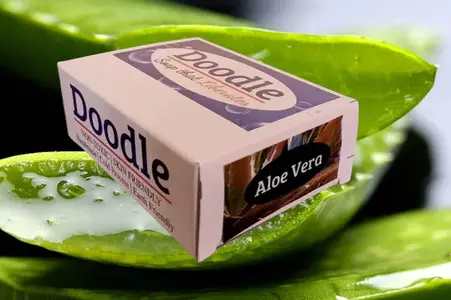 Doodle Information Portal
Doodle Information Portal
Aloe vera is a hardy and thorny succulent that grows in dry, hot climates. It is not clear as to where on earth it originated but it is believed to be endemic to Sudan.
There are several varieties of Aloe plant (examples Aloe Africana, Aloe Ferox , Aloe Vera, Aloe aculeata, Aloe Broomii a.k.a Snake Aloe). Aloe vera, called aloe barbadensis in scientific parlance is the most popular and useful to man!
The leaf of the aloe vera plant is rich in many vitamins, minerals, enzymes and sugars. It is also very useful as a medicine, because of its antioxidant, laxative, antibacterial, antifungal, antiviral and antitumor properties.
According to a reasearch article published by NCBI, , Aloe vera contains 75 potentially active constituents including vitamins, enzymes, minerals, sugars, lignin, saponins, salicylic acids and amino acids [1].
Legend has it that ancient Egyptians called aloe vera as the “Plant of Immortality”.
Aloe vera leaf has two main ingredients:
(a) the gel inside the succulent leaves (transparent and tasteless)Consuming aloe vera gel or aloe vera juice daily is touted to be a remedy for many ailments, including constipation & type 2 diabetes,
However, there are conflicting opinions on the safety of aloe vera latex or gel intake. There have been reports of liver failure in patients taking aloe vera extract [2].
While we do not recommend consumption of aloe vera gel or latex, as a topical medicine and skin-care aid, aloe vera gel is simply unsurpassed!
Applying farm fresh aloe vera gel, has been very effective in the treatment of
So it is a great plant that is hard to ignore and has many excellent uses.[3]
Aloe vera gel has been used very successfully in native form as face mask, hair mask, moisturizer and as an additive in bath soap.
Be warned, however, that people allergic to latex may react badly to aloe vera gel. Please do a patch test before you try it fully. Discontinue if you develop any rashes or itching or irritation. consult your doctor if need be.
Aloe vera gel is a moisturizer, antibacterial cream and antifungal medicine all in one. It is also very effective in removing blackheads and pigmentation. We give below three simple face masks using aloe vera gel that will improve your skin texture and complexion greatly!
Mix aloe vera gel, organic besan(chickpea) flour & curd (dahi in Hindi, thayir in Tamil) in a blender or by hand. You can vary the quantities to get your desired consistency. Add RO water if required.
Make into a fine paste and apply all over the face. Leave for 15 minutes and wash off with cool water.
Add honey and water to aloe vera gel and turn that into a juice like mix in a blender(mixie).
Make into a fine paste and apply all over the face. Leave for 15 minutes and wash off with cool water.
Mix aloe vera gel, french pink clay (or multani mitti) and rose water and blend to a nice consistency.
Make into a fine paste and apply all over the face. Leave for 15 minutes and wash off with cool water.
Because of its anti-fungal property, aloe vera gel can be very effective in treating scalp conditions like dandruff or cradle cap.
Aloe vera gel is rich in Vitamin E which is a great nourisher for our hair and scalp.
We always recommend using fresh aloe vera gel and not store bought gels. Because the preservatives in them may be bad for your skin and hair.
Blend both in a mixie/blender and form an easy to use fluid; vary the proportion of gel and oil to get your desired consistency.
Apply it deeply on your hair and scalp and leave it on for 30-45 minutes. Wash with shikakai or herbal shampoo or castile soap.
Apple cider vinegar by itself is great for the hair. Mixing it with aloe vera gel will greatly improve your hair and scalp health. This hair mask will give you volume and arrest hair fall over a period of time.
Aloe vera gel by itself is a great moisturizer. For one, it holds a lot of water and secondly it does a great job of protecting the outer skin from damage due to UV radiation (read sunlight!). So you can take aloe vera gel and mix it with rose water or RO water and pat it down on your skin which will protect your skin from drying up. For those with dry skin, this is a great herbal, non-toxic remedy
,The most important gotcha is that, it may feel a bit sticky, so you may want to wash it off after an hour or so (especially if you are going out)
A bath soap that has aloe vera gel added to it during preparation is called aloe vera soap.
Aloe vera gel, is a great additive to cold process soap (at Doodle Soap we believe that cold process soap is the only soap; melt and pour is for children doing a science project at school!).
If you do not want the messiness of handling aloe vera gel, but want all its benefits, then aloe vera soap is the best option for you.
There are three ways you can add aloe vera gel to a cold process soap.
1. Freeze aloe vera gel into ice cubes and then use that ice while preparing lye solution
2. Blend aloe vera gel with oils before blending with lye solution
3. Use aloe vera gel with essential oils.
Each method has its pros and cons. Cold process soaping can generate a lot of heat during saponification and this can kill a lot of goodies in the gel. Methods 1 and 2 have this drawback.
In method 3 you have the risk of aloe vera gel forming small lumps in the soap.
However, at Doodle Soap we have found (by trial and error) a fourth method of adding the gel which for obvious reasons we are not documenting here. This method preserves most of the nourishing elements in aloe vera gel as well as forms a smooth soap.
Aloe vera grows really well in small pots, plastic mugs and even shoe boxes. It needs plenty of sunlight and a well-rationed watering cycle. (I am talking in relation to the weather conditions of South India. I am not familiar with growing aloe vera in cold places)
Propagation can be done through leaf separation or pups; what I mean by leaf separation is that planting a single leaf can create an aloe vera plant provided the leaf retains a portion of the stem (cream colored bottom).
Experts recommend letting the fresh leaf dry for about a week till a film is formed around it and then pot it. If you plant the leaf with the stem then it should grow roots within a weeks.
Remember aloe vera is a very slow grower like cactus and one needs enormous patience (or like me complete indifference to the plant!) to get a good big plant.
It will take 4 years or so for an aloe vera plant to produce pups on its own. It will also take 3 years for it to grow big and you can cut the leaves to harvest the gel
Fill a well-drained pot with compost mixed with small pebble like stones or gravel and then pot your pup or leaf in it. For a beginner we recommend you buy a shoot from the local ornamental plant seller for Rs.25 or so and then plant it in a pot.
Care should be taken not to over-water the plant. We have found that it grows very well under bright hot sun as in Chennai!
This is done by cutting the leaves at the bottom of a mature plant (cut without damaging the stem).
The steps are
Aloe vera gel is a protein rich compound that is very wet and as such it is a perfect breeding ground for microbes! If exposed to air it will spoil in no time at all. (especially in the tropics).
It is best to fill it in glass or plastic jars with a lid, and then place the fresh gel in your deep freezer (0 - 2 degrees Celsius). It will last you for a long time as a fresh gel.
You can also use some form of Vitamin C (like lemon juice, or Vitamin C capsules, or citric acid) to preserve the gel, but I am not a big fan of this method. I think it interferes with the natural chemistry of aloe vera gel, but that is purely my opinion. Use it only if you have to transport it.
You can also pickle aloe vera gel in coconut oil to extend its shelf life for a few weeks. Even then, it is better to store it in a cold place or better to deep freeze it. Believe me, the tropics is no place to store anything!
After all we are blessed enough to be outdoors round the year, so why not have a few pots of aloe vera and then harvest and use as and when you need it!

We publish unbiased information on handmade soap, its benefits, disadvantages, how to choose your soap, various flavours of soap, their benefits and other useful information on handmade natural soaps.
We also publish well-researched informational articles on skin-care in general.
 Aloe Vera Soap Benefits
Aloe Vera Soap Benefits
 DIY Aloe Vera Soap
DIY Aloe Vera Soap